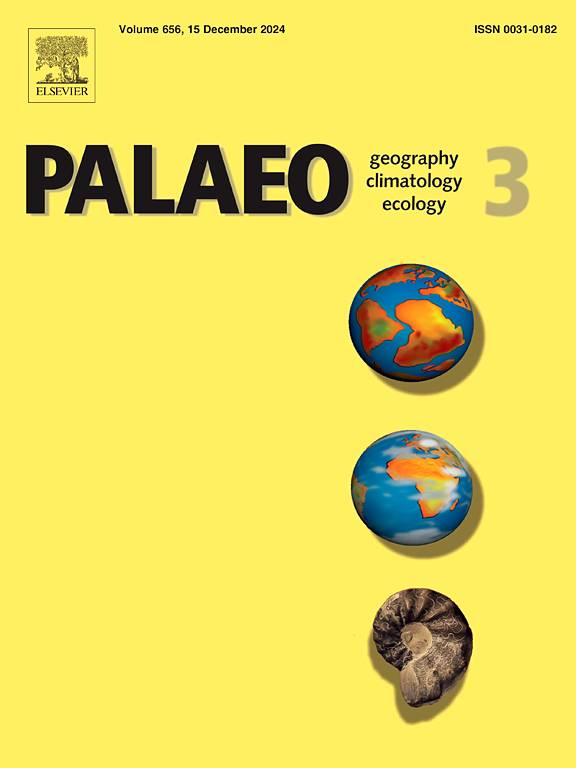中国北黄海DLC70-2岩芯的发光测年及其晚第四纪海侵意义
IF 2.7
2区 地球科学
Q2 GEOGRAPHY, PHYSICAL
Palaeogeography, Palaeoclimatology, Palaeoecology
Pub Date : 2025-02-24
DOI:10.1016/j.palaeo.2025.112842
引用次数: 0
摘要
可靠的年代学对于重建沉积历史和海平面波动至关重要。然而,由于缺乏对北黄海陆架晚第四纪沉积的可靠年龄,阻碍了我们对其沉积过程的认识。本研究利用石英光激发发光(OSL)和长石后红外(IR)红外激发发光(pIRIR)测年方案,建立了纽约州中部DLC70-2岩心最上层30 m的详细年代地层。根据岩性特征和有孔虫组合,确定了3个海侵层(T1、T2和T3),分别对应U1 (0 ~ 5.0 m)、U3 (10.0 ~ 18.5 m)和U5 (23.3 ~ 30.0 m)。U1的2个OSL年龄和6个4.9 ~ 10.3 ka的放射性碳年龄反映了海洋同位素阶段(MIS) 1的T1沉积。3个石英OSL和1个长石pIRIR年龄在67±7 ~ 45.1 ka范围内,表明U2沉积在MIS 4 - MIS 3早期。然而,由于石英OSL信号饱和(De > 150 Gy), U3沉积物的5个OSL年龄只产生了>;73±8 ~ >;53±4 ka的最小年龄。U3上部10.25 m长石年龄为76±7 ka,表明T2的形成不迟于MIS 5。通过交叉核对OSL和14C年龄,发现先前公布的前全新世沉积物14C年代显著低估。在U5中,23.65 m深度的长石年龄为191±17 ka,表明T3至少在MIS 7期间形成。利用渤海(BS)和黄海(YS)的10个岩心和目前更新的DLC70-2岩心年代地层资料,重建了全面的晚第四纪地层。在MIS 5期间出现了冷水种冷Buccella frigida和Protelphidium tuberculatum,表明存在类似于现今海洋环流的冷水团(气旋涡旋)。此外,晚第四纪地层对比也得到了前期滨海黄土年代地层重建的支持。这些发现将进一步加深我们对中国东部陆架晚第四纪沉积过程及其古环境变化的认识。本文章由计算机程序翻译,如有差异,请以英文原文为准。
Luminescence dating of core DLC70-2 from the North Yellow Sea in China and its implication for late Quaternary transgressions
Reliable chronology is crucial for reconstructing the sedimentary history and sea level fluctuations. However, the lack of robust ages for late Quaternary deposits on the North Yellow Sea (NYS) shelf hampered our understanding of its sedimentary processes. In this study, quartz optically stimulated luminescence (OSL) and feldspar post-infrared (IR) IR stimulated luminescence (pIRIR) dating protocols were utilized to establish a detailed chronostratigraphy for the upmost 30 m of core DLC70–2 from the central NYS. Based on lithology features and foraminifera assemblages, we identified three transgressive layers (T1, T2 and T3), corresponding to U1 (0–5.0 m), U3 (10.0–18.5 m) and U5 (23.3–30.0 m), respectively. In U1, two OSL and six radiocarbon ages of 4.9–10.3 ka indicate T1 deposition during Marine Isotope Stage (MIS) 1. For U2, three quartz OSL and one feldspar pIRIR ages ranging from >67 ± 7 to 45.1 ka suggest U2 deposition during MIS 4 - early MIS 3. However, due to quartz OSL signal saturation (De over 150 Gy), five OSL ages from U3 sediments only yield minimum ages of >73 ± 8 to >53 ± 4 ka. While the feldspar age of 76 ± 7 ka at 10.25 m in upper U3 indicates that T2 was formed no later than MIS 5. Significant underestimation in previous published 14C dates for pre-Holocene sediments was detected by cross-checking between OSL and 14C ages. In U5, a fading corrected feldspar age of 191 ± 17 ka at depth of 23.65 m suggests that T3 has formed at least during MIS 7. We reconstruct a comprehensive late Quaternary stratigraphy using ten cores obtained from the Bohai Sea (BS) and Yellow Sea (YS) and the current renewed chronostratigraphy of core DLC70–2. The occurrence of cold-water species Buccella frigida and Protelphidium tuberculatum during MIS 5 indicates there existed a cold-water mass (cyclonic eddy) similar to present-day marine circulation. Additionally, the late Quaternary stratigraphic correlation is supported by the previously chronostratigraphic reconstruction of coastal loess. These findings will enhance our comprehending on the sedimentary processes and their paleo-environment changes on the eastern Chinese shelves during late Quaternary.
求助全文
通过发布文献求助,成功后即可免费获取论文全文。
去求助
来源期刊
CiteScore
5.90
自引率
10.00%
发文量
398
审稿时长
3.8 months
期刊介绍:
Palaeogeography, Palaeoclimatology, Palaeoecology is an international medium for the publication of high quality and multidisciplinary, original studies and comprehensive reviews in the field of palaeo-environmental geology. The journal aims at bringing together data with global implications from research in the many different disciplines involved in palaeo-environmental investigations.
By cutting across the boundaries of established sciences, it provides an interdisciplinary forum where issues of general interest can be discussed.

 求助内容:
求助内容: 应助结果提醒方式:
应助结果提醒方式:


